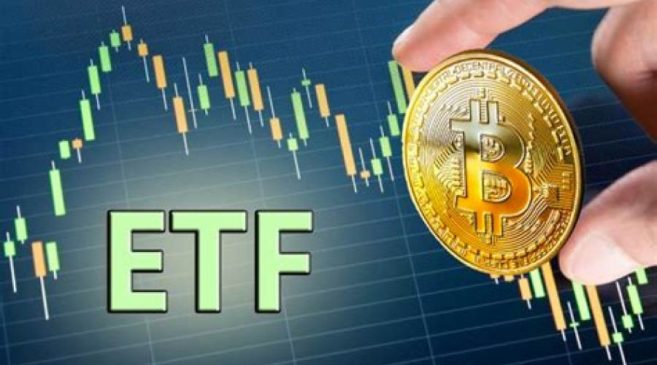2021 has been a busy, and at times chaotic, period for cryptocurrency ETFs in a year when Bitcoin prices have reached new record-breaking highs and when the Australian ETF industry showed no sign of slowing with a fresh market capitalisation of $126.9 billion being recorded in October.
Innovators in the cryptocurrency space have been keen to see the ETF marketplace evolve for several years now, with the first application for a U.S. Bitcoin exchange-traded fund filed as far back as 2013. And, given the renewed level of interest in Bitcoin from both institutional and retail investors, the time could not be more ripe.
Yet, despite multiple applications piling up, the U.S. Securities and Exchange Commission has so far rejected every single application for a Bitcoin spot ETF. It did, however, break ground in October this year by approving ProShares’ Bitcoin Strategy ETF, which began trading on the New York Stock Exchange on October 19th. A second bitcoin futures ETF, the Valkyrie
Bitcoin Strategy ETF, also began trading on October 22nd. However, these products are futures ETFs rather than spot ETFs meaning the funds do not own Bitcoin directly. Instead, they track a derivative of the asset rather than holding the underlying asset itself.
Although the prospects for a spot Bitcoin ETF approval in the U.S. look unlikely well into 2022, Bitcoin spot ETFs exist in other parts of the world including Canada. Several crypto-focused ETFs are already trading on the Toronto Stock Exchange, of which Purpose is the largest. In June this year, Q.R. Capital’s Bitcoin exchange-traded fund became the first Bitcoin ETF in Latin America, and Canadian asset management firm 3iQ’s Bitcoin ETF began trading on Nasdaq Dubai.
Due to the lack of Bitcoin ETFs in Europe, most investors have explored other types of exchange-traded products such as Exchange-Traded Notes (ETNs), often marketed as ‘ETF like’ products. These are different types of unsecured debt securities that track an underlying index of securities. Alternatively, there are Exchange-Traded Commodities (ETCs), a kind of security that can offer traders and investors exposure to commodities.
Spot Bitcoin ETFs differ from existing products on the marketplace in several ways.
● ETFs trade like any other equity-like instrument, whereas other products are built as debt instruments that can be leveraged. This structure leads to significant counterparty risk.
● ETFs are centrally cleared and settled into a Central Securities Depository.
● ETNs and other ETPs are not centrally cleared and are often leveraged debt instruments. A Bitcoin ETF is a regulated product traded through regulated entities to keep investments secure, whereas other exchange-traded cryptocurrency products are not regulated and have no regulatory restrictions through the trading process.
● Last but not least, ETF prices are set in real-time and can be traded on
exchange as opposed to other types of ETPs, which can be more complex and time-consuming to enter and exit.
Enter Jacobi Asset Management
October 2021 brought exciting news across Europe when Jacobi Asset Management was approved to launch Europe’s first physically-backed Bitcoin ETF, regulated by the Guernsey Financial Services Commission (GFSC).
The goal of launching the fund was to address three significant hurdles to investment:
1. Adding a regulatory safety net.
2. Removing the technology risk associated with wallets and exchanges.
3. Ensuring no counterparty risk is involved in investing in Bitcoin and other digital assets.
The Jacobi Bitcoin ETF creates a secure safe way to gain exposure to Bitcoin investing. Firms, asset managers and advisors looking for cryptocurrency exposure now have an opportunity to serve the demand of their clients. Funds will be managed safely and invested in a well-understood manner that is familiar with exactly how they work today with a regulated and centrally cleared product.
What Does the Future Hold?
Looking into the crystal ball for 2022, it seems likely that more Bitcoin futures ETFs will be approved in the U.S., even if a spot Bitcoin ETF is still a long way off. Navigating this busy marketplace has become a lot more confusing for investors, so we offer some key tips for next year:
● Better education to make sure the structural differences between the types of products and the level of risk that investors will be exposed to becomes better understood.
● Expect increased details on regulatory insight, product transparency and industry benchmarking.
● Familiarise yourselves with this new categorisation of cryptocurrency products as they are only going to get more innovative into 2022.
● Lean in. The cryptocurrency space is becoming more mainstream by the day. We are at the tipping point of a very exciting new era of finance where traditional and decentralised finance meet. You won’t want to miss it.
2021 has been a busy, and at times chaotic, period for cryptocurrency ETFs in a year when Bitcoin prices have reached new record-breaking highs and when the Australian ETF industry showed no sign of slowing with a fresh market capitalisation of $126.9 billion being recorded in October.
Innovators in the cryptocurrency space have been keen to see the ETF marketplace evolve for several years now, with the first application for a U.S. Bitcoin exchange-traded fund filed as far back as 2013. And, given the renewed level of interest in Bitcoin from both institutional and retail investors, the time could not be more ripe.
Yet, despite multiple applications piling up, the U.S. Securities and Exchange Commission has so far rejected every single application for a Bitcoin spot ETF. It did, however, break ground in October this year by approving ProShares’ Bitcoin Strategy ETF, which began trading on the New York Stock Exchange on October 19th. A second bitcoin futures ETF, the Valkyrie
Bitcoin Strategy ETF, also began trading on October 22nd. However, these products are futures ETFs rather than spot ETFs meaning the funds do not own Bitcoin directly. Instead, they track a derivative of the asset rather than holding the underlying asset itself.
Although the prospects for a spot Bitcoin ETF approval in the U.S. look unlikely well into 2022, Bitcoin spot ETFs exist in other parts of the world including Canada. Several crypto-focused ETFs are already trading on the Toronto Stock Exchange, of which Purpose is the largest. In June this year, Q.R. Capital’s Bitcoin exchange-traded fund became the first Bitcoin ETF in Latin America, and Canadian asset management firm 3iQ’s Bitcoin ETF began trading on Nasdaq Dubai.
Due to the lack of Bitcoin ETFs in Europe, most investors have explored other types of exchange-traded products such as Exchange-Traded Notes (ETNs), often marketed as ‘ETF like’ products. These are different types of unsecured debt securities that track an underlying index of securities. Alternatively, there are Exchange-Traded Commodities (ETCs), a kind of security that can offer traders and investors exposure to commodities.
Spot Bitcoin ETFs differ from existing products on the marketplace in several ways.
● ETFs trade like any other equity-like instrument, whereas other products are built as debt instruments that can be leveraged. This structure leads to significant counterparty risk.
● ETFs are centrally cleared and settled into a Central Securities Depository.
● ETNs and other ETPs are not centrally cleared and are often leveraged debt instruments. A Bitcoin ETF is a regulated product traded through regulated entities to keep investments secure, whereas other exchange-traded cryptocurrency products are not regulated and have no regulatory restrictions through the trading process.
● Last but not least, ETF prices are set in real-time and can be traded on
exchange as opposed to other types of ETPs, which can be more complex and time-consuming to enter and exit.
Enter Jacobi Asset Management
October 2021 brought exciting news across Europe when Jacobi Asset Management was approved to launch Europe’s first physically-backed Bitcoin ETF, regulated by the Guernsey Financial Services Commission (GFSC).
The goal of launching the fund was to address three significant hurdles to investment:
1. Adding a regulatory safety net.
2. Removing the technology risk associated with wallets and exchanges.
3. Ensuring no counterparty risk is involved in investing in Bitcoin and other digital assets.
The Jacobi Bitcoin ETF creates a secure safe way to gain exposure to Bitcoin investing. Firms, asset managers and advisors looking for cryptocurrency exposure now have an opportunity to serve the demand of their clients. Funds will be managed safely and invested in a well-understood manner that is familiar with exactly how they work today with a regulated and centrally cleared product.
What Does the Future Hold?
Looking into the crystal ball for 2022, it seems likely that more Bitcoin futures ETFs will be approved in the U.S., even if a spot Bitcoin ETF is still a long way off. Navigating this busy marketplace has become a lot more confusing for investors, so we offer some key tips for next year:
● Better education to make sure the structural differences between the types of products and the level of risk that investors will be exposed to becomes better understood.
● Expect increased details on regulatory insight, product transparency and industry benchmarking.
● Familiarise yourselves with this new categorisation of cryptocurrency products as they are only going to get more innovative into 2022.
● Lean in. The cryptocurrency space is becoming more mainstream by the day. We are at the tipping point of a very exciting new era of finance where traditional and decentralised finance meet. You won’t want to miss it.




